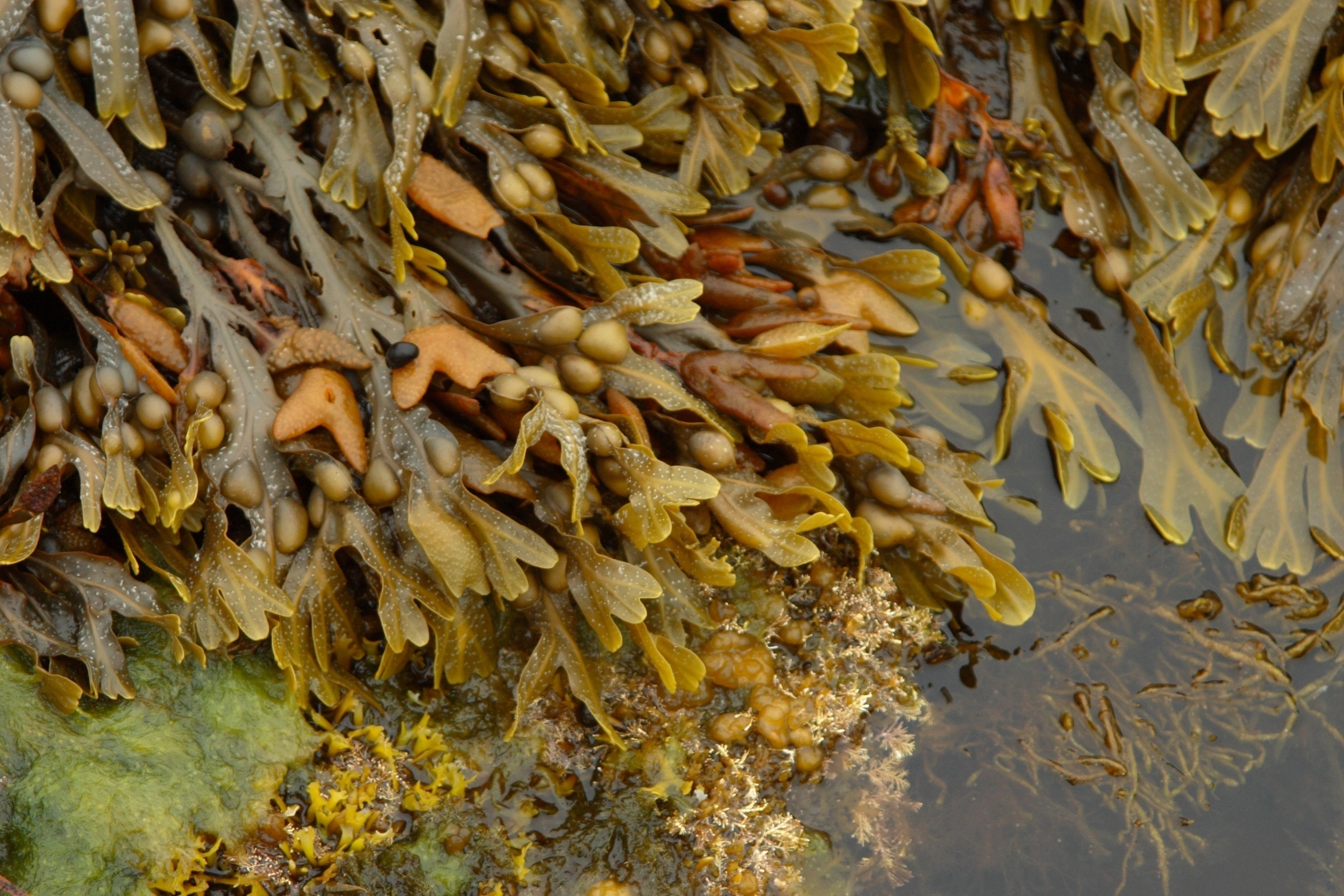Fucus vesiculosis (L)
Synonyms: Kelp, black tang, rockweed, sea wrack, kelp-ware, bladder fucus, cutweed, Quercus marina, cutweed, blasentang, seetang, meeriche
Order: Fucaceae
Description: Fucus is a common seaweed in the form of long ribbons, about 1m long and 5cm across, leathery, shiny, olive-green to yellow-brown. Down the centre of each ribbon is a midrib, on either side of which are the air-filled bladders which keep the alga floating up from its rocky anchorages. It is found on the north Atlantic and Baltic coasts, the Irish and North Seas and is often washed up on beaches after storms.

Parts used: The whole plant
Collection: It is best to collect bladderwrack from the sea in its healthy, live state than to gather it from beaches. It should be dried as soon as possible.
Constituents: Mucilage, algin and mannitol, beta-carotene and zeaxanthin; iodine, bromine, potassium, and many other minerals, volatile oil
Actions: Anti-hypothyroid, thyroactive, anti-obesic, antirheumatic, demulcent, gentle metabolic stimulant, nutritive, adaptagen, thyroid tonic, anti-inflammatory
Indications: myxoedema, lymphadenoid goitre, obesity, rheumatism, rheumatoid arthritis
Therapeutics and Pharmacology: Fucus, rich in iodine, stimulates the thyroid gland, thereby increasing basal metabolism. It is a useful remedy in the treatment of hypothyroidism, goitre myxoedema and lymphadenoid goitre. By regulating thyroid function, there is an improvement in all the associated symptoms. Fucus also appears to assist in the problem of lipid balance associated with obesity, and where obesity is associated with thyroid dysfunction, this herb may help to reduce excess weight. It has a reputation in the relief of rheumatism and rheumatoid arthritis and may be used both internally and as an external application for inflamed joints. The main phytotherapeutic use of Fucus is during debility and convalescence, and also to remineralise the body.
Combinations: Fucus combines well with Gaultheria in a paraffin base for application as a plaster to affected joints in rheumatoid arthritis.
Caution: Fucus should not be used in cases of hyperthyroidism or cardiac problems, or during pregnancy and lactation. Excessive dosage may lead to hyperthyroidism, tremor, increased pulse rate and elevated blood pressure. However, there is wide variation between individuals in susceptibility to excess iodine. Current US guidelines on iodine intake imply that 100 micrograms a day is considered safe. Like many sea creatures, bladderwrack is at risk from heavy metal pollution, and should not be collected where levels of cadmium and mercury are known to be high.
Preparation and Dosage: (thrice daily)
Regulatory Status: GSL
Dried thallus: 5-10g or by infusion
Liquid Extract: 1:1 in 25% alcohol, 4-8ml
Additional Comments: This seaweed was the original source of iodine, discovered in 1812. and it was used extensively to treat goitre, a swelling of the thyroid related to lack of iodine. In the 1860s it was claimed that bladderwrack, as a thyroid stimulant, could counter obesity by increasing metabolic rate, and, since then, it has featured in numerous slimming remedies. Farmers in the south of England use bladderwrack as a potash fertiliser.
Bibliography
Bradley, P.R. (ed.) 1992 British Herbal Compendium, Volume 1, BHMA, Bournemouth.
BHMA 1983 British Herbal Pharmacopoeia, BHMA, Bournemouth.
Grieve, M. 1931 A Modern Herbal, (ed. C.F. Leyel 1985), London.
Hoffmann, D. 1990 The New Holistic Herbal, Second Edition, Element, Shaftesbury.
Mabey, R. (ed.) 1991 The Complete New Herbal, Penguin, London.
Mills, S.Y. 1993 The A-Z of Modern Herbalism, Diamond Books, London.
Ody, P. 1993 The Herb Society's Complete Medicinal Herbal, Dorling Kindersley, London.
Polunin, M. and Robbins, C. 1992 The Natural Pharmacy, Dorling Kindersley, London.
Weiss, R.F. 1991 Herbal Medicine, Beaconsfield Arcanum, Beaconsfield.
Wren, R.C. 1988 Potter's New Cyclopaedia of Botanical Drugs and Preparations, C.W.Daniel, Saffron Walden.










